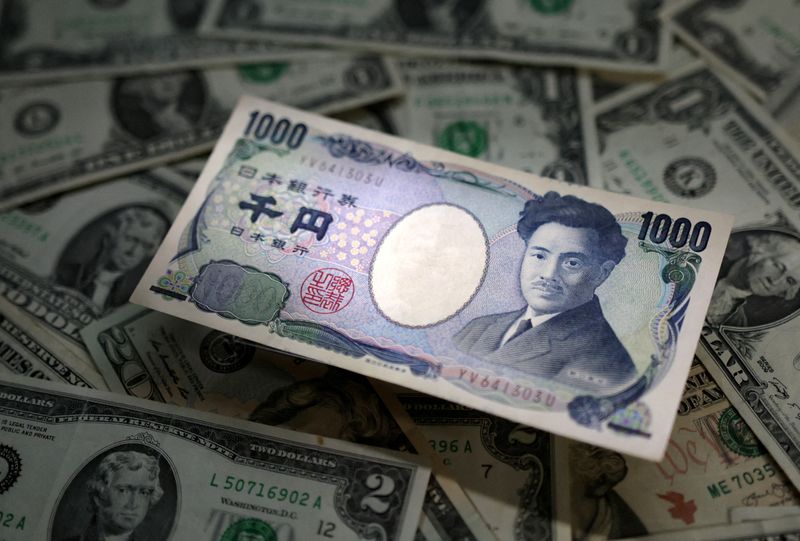Forex
US dollar hits six-week high; yen falls in wake of BOJ decision


© Reuters. FILE PHOTO: Japanese Yen and U.S. dollar banknotes are seen in this illustration taken March 10, 2023. REUTERS/Dado Ruvic/Illustration/File Photo
By Gertrude Chavez-Dreyfuss
NEW YORK (Reuters) -The dollar climbed to six-week peaks against a basket of currencies on Tuesday, as investors resumed buying the greenback after a brief respite, on continued expectations the Federal Reserve would be in no rush to cut interest rates given a still stable U.S. economy.
The rose to a six-week high of 103.76, and was last at 103.62, up 0.2%.
“Since the start of the year, the dollar has been recovering and correcting back on what would I say as excessive improvement in risk sentiment and expectations of lower rates at the end of last year. So we’re just unwinding that,” said Amo Sahota, director at FX consulting firm Klarity FX in San Francisco.
“I don’t expect the dollar index to go back above the mid-December high of 104 and a quarter area. But this correction may have a little more room to run through, but I don’t expect the dollar to push past there without any new news.”
The U.S. currency earlier fell against the Japanese yen after the Bank of Japan, in its policy meeting on Tuesday, maintained its ultra-easy policy, as expected, but signaled an April exit from negative interest rates. But the dollar has since gained against the yen, last up 0.2% at 148.385 yen.
“The details of the BoJ communication shows they’re getting more comfortable with the idea that inflation is on track towards their target,” said Vassili Serebriakov, FX strategist, at UBS in New York.
“It did reinforce expectations of policy normalization in April. But it’s less clear if it would be a significant event for the yen because it’s widely expected.
The yen first weakened after the BOJ decision, with the dollar hitting 148.60 yen. The Japanese currency is sensitive to the rate differentials between Japan and other markets, and has shed nearly 5% against the dollar this year as markets reduced bets on imminent U.S rate cuts.
The U.S. rate futures market on Tuesday priced in a roughly 47% chance of a March rate cut, up from late on Monday, but down from as much 80% about two weeks ago, according to LSEG’s rate probability app. For 2024, futures traders are betting on five rate cuts of 25 bps each. Two weeks ago they expected six.
Elsewhere, the euro fell to a six-week low of $1.0822, and last traded down 0.4% at $1.08455.
Investors are gearing up for the European Central Bank policy meeting on Thursday. No change in interest rates is expected but investors will watch the tone of the ECB statement and ECB President Christine Lagarde’s press conference for clues on where rates are headed
Money markets are currently pricing a reasonable chance of a rate cut by April.
The Bank of Canada will also hold a policy meeting on Wednesday. It is expected to leave its key overnight rate unchanged at a 22-year high of 5% and is also due to update its forecasts on inflation and economic growth.
Ahead of the decision, the U.S. dollar was down 0.1% at C$1.3465.
In other currencies, the pound fell 0.2% against the dollar to $1.2678.
The main British economic news was a smaller-than-expected budget deficit for December, which could open up room for tax cuts in a budget scheduled for March.
In China, a report that its is considering a rescue package for its plunging stock markets helped the yuan and the Australian dollar, often viewed as a more liquid proxy for exposure to China.
Chinese authorities are considering measures to stabilize the stock market, Bloomberg News reported, citing people familiar with the matter.
The dollar fell 0.4% against the to 7.166, while the was flat at US$0.6569.

 Forex3 years ago
Forex3 years agoForex Today: the dollar is gaining strength amid gloomy sentiment at the start of the Fed’s week

 Forex3 years ago
Forex3 years agoUnbiased review of Pocket Option broker

 Forex3 years ago
Forex3 years agoDollar to pound sterling exchange rate today: Pound plummeted to its lowest since 1985

 Forex3 years ago
Forex3 years agoHow is the Australian dollar doing today?

 Cryptocurrency3 years ago
Cryptocurrency3 years agoWhat happened in the crypto market – current events today

 World3 years ago
World3 years agoWhy are modern video games an art form?

 Commodities3 years ago
Commodities3 years agoCopper continues to fall in price on expectations of lower demand in China

 Economy3 years ago
Economy3 years agoCrude oil tankers double in price due to EU anti-Russian sanctions





















